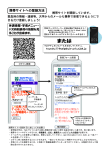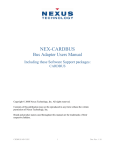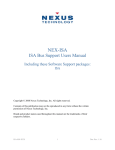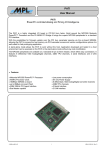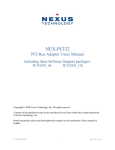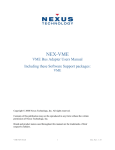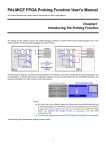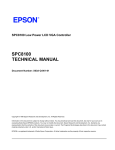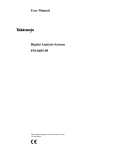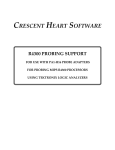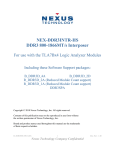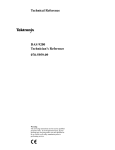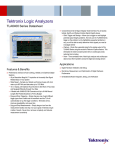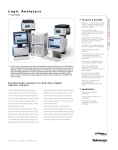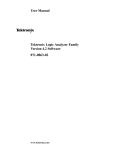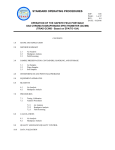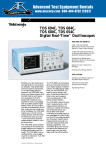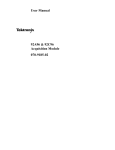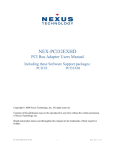Download NEX-MCA Manual
Transcript
NEX-MCA Users Manual Including these Software Support packages: MCA Copyright © 2008 Nexus Technology, Inc. All rights reserved. Contents of this publication may not be reproduced in any form without the written permission of Nexus Technology, Inc. Brand and product names used throughout this manual are the trademarks of their respective holders. MCA-MN-XXX 1 Doc. Rev. 1.10 Warranty Terms and License Agreement For warranty terms, refer to the Terms and Conditions of Sale document that was included in the product shipment. The Software License Agreement is displayed during installation. A hardcopy of that agreement may be obtained from Nexus Technology. All Nexus Technology products to which this manual refers are subject to the Terms and Conditions of Sale document and the Software License Agreement, as appropriate. Compliance with WEEE and RoHS Directives This product is subject to European Union regulations on Waste Electrical and Electronics Equipment. Return to Nexus Technology for recycle at end of life. Costs associated with the return to Nexus Technology are the responsibility of the sender. MCA-MN-XXX 2 Doc. Rev. 1.10 TABLE OF CONTENTS 1.0 OVERVIEW ........................................................................................................................... 4 1.1 General Information............................................................................................................ 4 2.0 SOFTWARE INSTALLATION ............................................................................................. 4 2.1 TLA700............................................................................................................................... 4 2.2 DAS9200............................................................................................................................. 5 3.0 CONFIGURING the NEX-MCA BUS ADAPTER ............................................................... 5 3.1 General Information............................................................................................................ 5 4.0 CONNECTING to the NEX-MCA ADAPTER...................................................................... 6 4.1 General................................................................................................................................ 6 4.2 TLA700............................................................................................................................... 6 4.3 92A96.................................................................................................................................. 6 5.0 CLOCK SELECTION ............................................................................................................ 8 5.1 General Information............................................................................................................ 8 6.0 VIEWING DATA ................................................................................................................... 8 6.1 Viewing State Data on the TLA700 ................................................................................... 8 6.2 Viewing Timing Data on the TLA700................................................................................ 8 6.3 Viewing State Data on the DAS9200/TLA500 .................................................................. 9 6.4 Viewing Timing Data on the DAS9200/TLA500............................................................... 9 APPENDIX A - Necessary Signals for Clocking ......................................................................... 10 APPENDIX B - Considerations.................................................................................................... 11 B.1 MCA Loading .................................................................................................................. 11 B.2 "Patch" Areas ................................................................................................................... 11 APPENDIX C - Modifying the NEX-MCA Adapter ................................................................... 12 APPENDIX D - MCA Bus Pinout................................................................................................ 13 APPENDIX E - References .......................................................................................................... 15 APPENDIX F - Support................................................................................................................ 16 TABLE OF TABLES Table 1- NEX-MCA TLA700 / 92A96 Wiring .............................................................................. 7 Table 2- MCA BusOp Symbol Table ............................................................................................. 9 MCA-MN-XXX 3 Doc. Rev. 1.10 1.0 OVERVIEW 1.1 General Information The NEX-MCA adapter has been designed to provide quick and easy connections to interface a 102- or 136-channel TLA700, a 92A96, or a 92C96 acquisition module to a MCA backplane. (The MCA designation refers to the Micro Channel Architecture specification.) In addition, the method of connection permits the use of other measurement devices such as oscilloscopes. The included software will permit the acquisition of MCA bus cycles, and will display the data in easy-to-read symbolic form rather than raw hexadecimal or binary data. Please note that this manual uses some terms generically. For example, references to a 92A96 acquisition card apply to a 92C96 acquisition card; references to the DAS9200 apply equally to the TLA500; and references to the TLA700 apply to a TLA704/714 or TLA711/720 chassis with one or more 7L3/4 or 7M3/4 acquisition cards. This manual assumes that the user is familiar with the MCA backplane specification and the Tektronix TLA700, DAS9200, or TLA500 Logic Analyzer. Also, in the case of the TLA700, it is expected that the user is familiar with Windows 95/98. For information on using a Prism 32GPX/GPD module with this support, or if 5¼" DAS floppies are needed, please contact Nexus Technology. See Appendix E for contact information. 2.0 SOFTWARE INSTALLATION Two 3½” diskettes have been included with the NEX-MCA Bus Adapter. One is for use with the TLA700 series, the other is to be used with a DAS9200 or TLA500. 2.1 TLA700 The MCA support software is loaded in the same method as other Win95/98 programs. Place the NEX-MCA Install disk in the floppy drive of the TLA700. Select Control Panel and run Add/Remove Programs, choose Install, Next, then Finish. Add/Remove will then run SETUP.EXE on the floppy and install the support in its proper place on the hard disk. To load a support into the TLA700, first select the desired Logic Analyzer card in the Setup screen, select Load Support Package from the File pull-down, then choose MCA and click on Okay. Note that for either support the Logic Analyzer card must be at least 102-channels in width. MCA-MN-XXX 4 Doc. Rev. 1.10 2.2 DAS9200 The included diskette should be loaded onto the DAS9200 using the Install Application function. This function is available from the Disk Services menu of the DAS. For more information, refer to the Tektronix DAS9200 or TLA500 System User's Manual. Load the desired support from within the 92A96 Config menu by choosing "MCA Support” and pressing <RETURN>. The channel grouping, clocking and symbols will then be loaded. 3.0 CONFIGURING the NEX-MCA BUS ADAPTER 3.1 General Information The number of signals defined by the Micro Channel specification exceeds the channel count of a 92A96, or 102-channel TLA. Because of this, three jumper blocks have been defined - JP2, JP3, and JP4. By placing a shorting jumper across the pair of pins next to the desired signal name, that signal can then be monitored during the acquisition. For information on physically modifying the NEX-MCA adapter to monitor signals not provided with the standard implementation, refer to Appendix C. JP2 is used to select between SDSTRB~ and the derived signal DSDSTRB~. For proper clocking of Streaming Data activity the jumper should be set for DSDSTRB~ (connecting pins 2 and 3, the leftmost two pins). For high speed timing purposes, it may be desired to view the actual SDSTRB~ signal. In these cases, the jumper should be placed between pins 1 and 2, the rightmost two pins. JP3 selects between CHRESET and SDCLK. To monitor CHRESET the jumper should connect pins 1 and 2 (the rightmost two). Placing the jumper between pins 2 and 3 (the leftmost pair) will permit monitoring the SDCLK signal. JP4 is used to select which IRQ line should be monitored. Using the jumper, short the two pins adjacent to the desired IRQ signal. MCA-MN-XXX 5 Doc. Rev. 1.10 4.0 CONNECTING to the NEX-MCA ADAPTER 4.1 General Although taller than a standard Micro Channel module, the NEX-MCA adapter is designed to plug directly into any Micro Channel backplane slot. The board length and connector spacing conforms to Micro Channel specifications. 4.2 TLA700 When using NEX-MCA support with a TLA700 containing a 7L3/4 or 7M3/4 acquisition module, the necessary acquisition data sections are A0-A3, D0-D3, and C0-C3. These grouped channels (8 podlets to a group) should be connected to the locations denoted for the A96. Follow the silk-screened information on the board that shows the proper relationship between the signal and reference inputs. When properly connected, the sides of the podlets that have writing on them should be visible. Connect the four clock leads to their specified locations at J12 (the only connector with 4 locations). Again, follow the silk-screened information to properly connect the clock input and its ground. Table 1 shows the wiring and Channel Grouping for the TLA700 when used with the NEX-MCA adapter. 4.3 92A96 When using a 92A96, connect the grouped pods (8 podlets to a group) to their appropriate locations by following the silkscreen information printed on the adapter board. The 92A96 pods are labeled A0-A3, D0-D3, and C0-C3. Each pod has its proper location denoted on the silkscreen of the adapter board. When attaching the pods, follow the silkscreen information on the board showing the ground and signal pin locations. When properly connected, the colored sides of the podlets should be visible. Connect the four clock leads (one per A96 cable) to their specified locations at J16 (the only connector with 4 locations). Again, follow the silkscreened information to properly connect the clock input and its ground. Table 1 shows the wiring and Channel Grouping for the 92A96. MCA-MN-XXX 6 Doc. Rev. 1.10 Group Name Address (Hex) BusOp (Sym BusSize (Hex) Clocks Signal Name A31 A30 A29 A28 A27 A26 A25 A24 A23 A22 A21 A20 A19 A18 A17 A16 A15 A14 A13 A12 A11 A10 A9 A8 A7 A6 A5 A4 A3 A2 A1 A0 TC~ MSDR~ SDR1~ SDR0~ REFRESH~ DSDSTRB~ M/IO~ S1~ S0~ TR32 DS32RTN~ DS16RTN~ BE3~ BE2~ BE1~ BE0~ CMD~ MSDR~ MCA Pin # B86 B85 B84 A84 A83 A82 B82 B81 B06 B07 B08 B10 B11 B12 B14 B15 B16 B18 B19 B20 A04 A05 A06 A08 A09 A10 A12 A13 A14 A16 A17 A18 A30 B62 B61 B44 A45 * A34 A33 A32 B80 A79 A44 A78 B78 B77 B76 B34 B62 TLA700 / 92A96 input A3:7 A3:6 A3:5 A3:4 A3:3 A3:2 A3:1 A3:0 A2:7 A2:6 A2:5 A2:4 A2:3 A2:2 A2:1 A2:0 A1:7 A1:6 A1:5 A1:4 A1:3 A1:2 A1:1 A1:0 A0:7 A0:6 A0:5 A0:4 A0:3 A0:2 A0:1 A0:0 C0:1 C3:3 C2:3 C2:2 C2:5 C2:0 C0:0 C3:5 C3:4 C0:4 C0:7 C0:6 C1:3 C1:2 C1:1 C1:0 CLK0 CLK2 Group Name Data (Hex) Misc (Hex) Arb (Hex) Clocks Signal Name D31 D30 D29 D28 D27 D26 D25 D24 D23 D22 D21 D20 D19 D18 D17 D16 D15 D14 D13 D12 D11 D10 D9 D8 D7 D6 D5 D4 D3 D2 D1 D0 IRQn~ SFDBKRT~ CHCK~ RST/SDCK MADE24 SBHE~ CHRDYRTN ADL~ CMD~ BURST~ PREEMPT~ ARB/GNT~ ARB3 ARB2 ARB1 ARB0 SDCLK unused MCA Pin # A75 A74 B74 B73 B72 A72 A71 A70 B69 B68 A68 A67 A66 B66 B65 B64 B53 B52 B51 A51 A50 A49 B49 B48 A42 A41 A40 B40 B39 A38 B38 A37 --A64 B32 --A02 A54 B35 A20 B34 A22 A21 --A28 A26 A25 A24 * TLA700 / 92A96 input D3:7 D3:6 D3:5 D3:4 D3:3 D3:2 D3:1 D3:0 D2:7 D2:6 D2:5 D2:4 D2:3 D2:2 D2:1 D2:0 D1:7 D1:6 D1:5 D1:4 D1:3 D1:2 D1:1 D1:0 D0:7 D0:6 D0:5 D0:4 D0:3 D0:2 D0:1 D0:0 C2:6 C0:5 C3:6 C3:7 C0:3 C3:0 C2:1 C2:4 C2:7 C0:2 C3:2 C3:1 C1:7 C1:6 C1:5 C1:4 CLK1 CLK3 Table 1- NEX-MCA TLA700 / 92A96 Wiring * Derived signal MCA-MN-XXX 7 Doc. Rev. 1.10 5.0 CLOCK SELECTION 5.1 General Information All Micro Channel data is acquired using either both edges of CMD~ (for standard cycles) or a combination of CMD~ and the synthesized SDCLK (for Streaming Data cycles). The circuitry on the NEX-MCA Bus Adapter is used to provide the necessary clock edges at the necessary times for properly acquiring Streaming Data cycles. 6.0 VIEWING DATA 6.1 Viewing State Data on the TLA700 After making an initial acquisition, the TLA700 will display the data in the Listing (State) format. Address and Data information are displayed as hexadecimal values; Bus Operation data is displayed using symbols; Miscellaneous, Bus Size, and the Arbitration signal groups are all displayed in hexadecimal radix. The use of Symbol Tables when displaying state data enables the user to quickly determine what type of bus cycle was acquired. One symbol table (Table 2) has been provided to show the type of transaction that occurred on the MCA bus, and its filename is "MCA_BUS.TSF". This symbol table quickly shows whether the acquisition was of a memory or I/O operation, whether it was a read or a write, etc. It is important to note that changing the group, channel, or wiring of the Bus Operation group can result in incorrect symbol information being displayed. 6.2 Viewing Timing Data on the TLA700 By default, the TLA700 will display an acquisition in the Listing (State) mode. However, the same data can be displayed in Timing form by adding a Waveform Display window. This is done by clicking on the Window pull-down, selecting New Data Window, clicking on Waveform Window Type, then choosing the Data Source. Two choices are presented: MCA and MCAMagniVu. The first (MCA) will show the exact same data (same acquisition mode) as that shown in the Listing window, except in Timing format. The second selection, MCA-MagniVu, will show all of the channels in 2GHz MagniVu mode, so that edge relationships can be examined at the module’s trigger point. With either selection, all channels can be viewed by scrolling down the window. Refer to the TLA700 System User’s Manual for additional information on formatting the Waveform display. MCA-MN-XXX 8 Doc. Rev. 1.10 Pattern xx0xxxx 0x1xxxx 101x101 101x110 111xx11 111x101 111x110 111xx00 111x001 111x010 TLA700 / 92A96 Symbol Refresh Reserved StrmngDataMemRead StrmngDataMemWrite Inactive Memory Read Memory Write Reserved I/O Read I/O Write Table 2- MCA BusOp Symbol Table Signals, from left to right: TC~, MSDR~, SDR1~, SDR0~, REFRESH~, DSDSTRB~, M/IO~, S1~, S0~ 6.3 Viewing State Data on the DAS9200/TLA500 After an acquisition is made the DAS9200 Logic Analyzer will display the data in State Display mode (as a default only). Address and Data information are displayed as hexadecimal values; Bus Operation data is displayed using symbols; Miscellaneous, Bus Size, and the Arbitration signal groups are all displayed in hexadecimal radix. The use of Symbol Tables when displaying state data enables the user to quickly determine what type of bus cycle was acquired. One symbol table (Table 2) has been provided to show the type of transaction that occurred on the MCA bus, and its filename is "MCA_BUS". This symbol table quickly shows whether the acquisition was of a memory or I/O operation, whether it was a read or a write, etc. It is important to note that changing the group, channel, or wiring of the Bus Operation group can result in incorrect symbol information being displayed. 6.4 Viewing Timing Data on the DAS9200/TLA500 It may be useful to display acquired information using the Timing Diagram display of the DAS9200. (Note that, unlike some other logic analyzers, with the DAS9200 there is no need to re-acquire MCA data when changing from one display mode to another. The same data can be viewed in either format.) This method of data display can be particularly useful when an asynchronous acquisition has been made (using the DAS9200 internal acquisition clock) to determine the relationships between signal edges. Refer to the appropriate Tektronix DAS 92A96 Module User's Manual for more detailed information on formatting the display of the acquired data. MCA-MN-XXX 9 Doc. Rev. 1.10 APPENDIX A - Necessary Signals for Clocking To properly acquire Micro Channel backplane activity, the following signals must be provided: CMD~, MSDR~, CHRDYRTN, SDR1~, SDR0~, and SDSTROBE~. However, SDSTROBE~ is only necessary when Streaming Data cycles are to be monitored. For all but Streaming Data cycles, Address information is acquired on the falling edge of CMD~, and the Data bus is acquired on the rising edge of CMD~. The other signals (MSDR~, CHRDYRTN, SDR1~, and SDR0~) are used as clocking qualifiers, or as cycle type determinants. In order to properly acquire Streaming Data bus cycles some circuitry had to be added to the NEX-MCA adapter. This circuitry generates the SDCLK and DSDSTRB~ signals used by the logic analyzer card to properly acquire these cycles. These signals DO NOT exist on the MCA backplane. MCA-MN-XXX 10 Doc. Rev. 1.10 APPENDIX B - Considerations B.1 MCA Loading It must be noted that the NEX-MCA Bus Adapter does not provide any buffering of the MCA backplane signals. This was a conscious design decision that was made by balancing the tradeoffs of possible backplane loading versus signal acquisition accuracy. By not introducing signal buffers it is possible, using the NEX-MCA adapter, to see the exact timing relationships and signal waveforms from the backplane. It is believed that the signal loading of the TLA700 or 92A96 acquisition cards is low enough so that MCA signal degradation will not occur. The NEX-MCA Adapter Board was designed so that the run lengths for critical signals (and those with the highest activity levels, such as the address / data bus) are as short as possible. This should help greatly in retaining signal integrity. B.2 "Patch" Areas If signal loading or reflection does become a concern, the capability exists to add series resistors to any MCA signal. Patch areas have been provided next to each TLA700/A96 connector, consisting of two rows of plated through holes. These areas (outlined on the silk-screen and labeled as Nxx) are suitable for individual resistors or resistor networks. To add a series resistor, simply cut the trace of the desired signal on the component side of the board, and solder the resistor between the two feed-throughs. MCA-MN-XXX 11 Doc. Rev. 1.10 APPENDIX C - Modifying the NEX-MCA Adapter As previously mentioned, the Micro Channel specification has too many signals to be able to acquire them all with just one 92A96 or 102-channel TLA acquisition card. Assumptions have been made as to what signals are of interest, but these assumptions may not be appropriate for every instance. For these occasions, the NEX-MCA adapter may be easily modified to monitor any desired signals. All MCA signals have been brought out to feed-throughs on the board, and there are three unused TLA/A96 connectors on the board (J4, J8, and J20). These connectors each have a series of holes beneath them (towards the edge connector) to provide easy solder points. Use wire wrap wire to connect the Micro Channel signals to these connectors. When changing the signals connected to an A96 pod, the channel grouping default in the TLA700/DAS 9200 will have to be changed appropriately. Refer to the TLA70 or DAS 9200 manuals for information on this procedure. Also note that if any of the signals to the MCA BusOp group are changed then the included Symbol Table will no longer be accurate. MCA-MN-XXX 12 Doc. Rev. 1.10 APPENDIX D - MCA Bus Pinout Pin # 1 2 3 4 5 6 7 8 9 10 11 12 13 14 15 16 17 18 19 20 21 22 23 24 25 26 27 28 29 30 31 32 33 34 35 36 37 38 39 40 41 42 43 44 45 46 MCA-MN-XXX Row B - Solder Side AUDIO GND AUDIO GND 14.3MHz OSC GND A23 A22 A21 GND A20 A19 A18 GND A17 A16 A15 GND A14 A13 A12 GND IRQ9~ IRQ3~ IRQ4~ GND IRQ5~ IRQ6~ IRQ7~ GND DPAREN~ DPAR0 CHCK~ GND CMD~ CHRDYRTN CD SFDBK~ GND D1 D3 D4 GND CHRESET SDSTROBE~ SDR0~ GND Key 13 Row A - Component Side CD SETUP~ MADE24 GND A11 A10 A9 +5V A8 A7 A6 +5V A5 A4 A3 +5V A2 A1 A0 +12V ADL~ PREEMPT~ BURST~ -12V ARB0 ARB1 ARB2 -12V ARB3 ARB/GNT~ TC~ +5V S0~ S1~ M/IO~ +12V CD CHRDY D0 D2 +5V D5 D6 D7 GND DS16RTN~ REFRESH~ key Doc. Rev. 1.10 MCA-MN-XXX Pin # 47 48 49 50 51 52 53 54 55 56 57 58 Row B - Solder Side Key D8 D9 GND D12 D14 D15 GND IRQ10~ IRQ11~ IRQ12~ GND Row A - Component Side key +5V D10 D11 D13 +12V DPAR1 SBHE~ CD DS16~ +5V IRQ14~ IRQ15~ Pin # 59 60 61 62 63 64 65 66 67 68 69 70 71 72 73 74 75 76 77 78 79 80 81 82 83 84 85 86 87 88 89 Row B - Solder Side Reserved Reserved SDR1~ MSDR~ GND D16 D17 D18 GND D22 D23 DPAR2 GND D27 D28 D29 GND BE0~ BE1~ BE2~ GND TR32 A24 A25 GND A29 A30 A31 GND APAR2 APAR3 Row A - Component Side Reserved Reserved GND Reserved Reserved SFDBKRTN~ +12V D19 D20 D21 +5V D24 D25 D26 +5V D30 D31 DPAR3 +12V BE3~ DS32RTN~ CD DS32~ +5V A26 A27 A28 +5V APAREN~ APAR0 APAR1 GND 14 Doc. Rev. 1.10 APPENDIX E - References Tektronix TLA700 System User’s Manual Tektronix TLA700 Logic Analyzer User’s Manual Tektronix DAS9200 / TLA500 System User’s Manual Tektronix 92A96 / 92C96 Module User’s Manual "The IBM PS/2 Hardware Interface Technical Reference" published by IBM, P/N S68X-2330-00 November 1989 "The Micro Channel Architecture Handbook" by Chet Heath and Winn L. Rosch published by Brady ISBN 0-13-583493-7 MCA-MN-XXX 15 Doc. Rev. 1.10 APPENDIX F - Support About Nexus Technology, Inc. Established in 1991, Nexus Technology, Inc. is dedicated to developing, marketing, and supporting Bus Analysis applications for Tektronix Logic Analyzers. We can be reached at: Nexus Technology, Inc. 78 Northeastern Blvd. #2 Nashua, NH 03062 TEL: 877-595-8116 FAX: 877-595-8118 Web site: http://www.nexustechnology.com Support Contact Information Technical Support General Information Quote Requests [email protected] [email protected] [email protected] We will try to respond within one business day. If Problems Are Found Document the problem and e-mail the information to us. If at all possible please forward a Saved System Setup (with acquired data) that shows the problem. Do not send a text listing alone as that does not contain enough data for analysis. To prevent corruption during the mailing process it is strongly suggested that the Setup be zipped before transmission. MCA-MN-XXX 16 Doc. Rev. 1.10
















